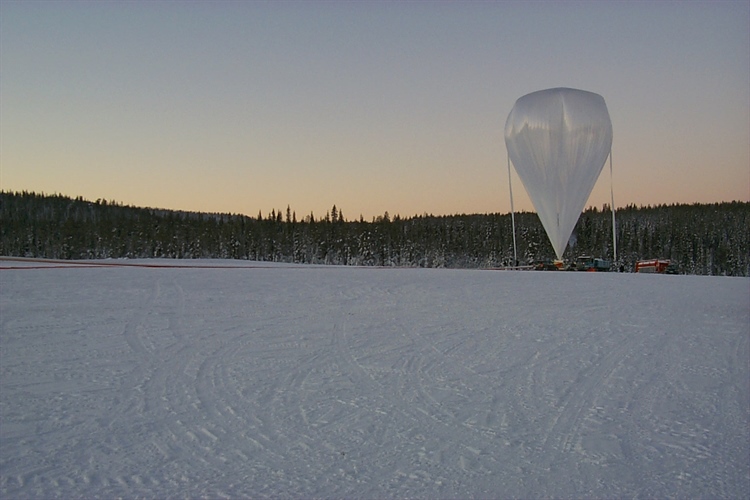Study published on reduced lifetime for a future strong greenhouse gas
May 2, 2017
 Balloon preparation launch in Kiruna, Sweden for NASA's SAGE III Ozone Loss and Validation Experiment (SOLVE) Campaign (Credit: NASA)
Balloon preparation launch in Kiruna, Sweden for NASA's SAGE III Ozone Loss and Validation Experiment (SOLVE) Campaign (Credit: NASA)
NOAA/ESRL scientists and their colleagues at the University of East Anglia, Utrecht University, and NCAR calculated an atmospheric lifetime of the trace gas, sulfur hexafluoride (SF6), based on measurements in the polar stratospheric vortex and modeled transport into the stratosphere. The atmospheric lifetime of sulfur hexafluoride (SF6) is reduced by nearly a factor of three based on measurements in the stratospheric polar vortex from 3200 to 850 years. The paper was recently published in the Journal of Geophysical Research-Atmospheres. Atmospheric SF6 is destroyed in the mesosphere by electron attachment. During descent in the springtime polar vortex, mesospheric air enters the stratosphere and the scientists were able to quantify its loss. The entire mass of the mesosphere (several times over) descends into each of the stratospheric polar vortices every year. This gas has one of the strongest global warming potential (GWP) of any atmospheric trace gas, about 23,000 times greater radiative forcing than one carbon dioxide molecule over a 100 year time horizon. Over a 500-year time horizon, atmospheric SF6 has a higher GWP of 34,900 times the CO2 molecule.
The current global mean atmospheric concentration measured by NOAA is above 9 parts-per-trillion (ppt), and is growing at rate of 4% per year. It will be a significant radiative forcing gas towards the end of this century. It is used in the distribution of electricity, because it is a dielectric gas and is the best electrical insulator used today. There is no known replacement. Using this gas in the power grid reduces also waste of fossil fuels and thereby helps to reduce emissions of carbon dioxide (CO2) into the atmosphere. It was one of six species regulated by the Kyoto Protocol international agreement that extended the 1992 United Nations Framework Convection on Climate Change (UNFCCC), which also included CO2, methane (CH4), nitrous oxide (N2O), the hydrochlorofluorcarbons (HFCs), the perfluorocarbons (PFCs). Consistency of SF6 and HFC-227ea derived mean age of air gives independent confirmation of the SF6 lifetime reduction. The signal of mesospheric loss or production of a trace gas is highly concentrated, and can be most easily measured for other gases, in the stratospheric polar vortices each winter. This technique may be useful to other gases, like the HFCs and PFCs that are destroyed in the mesosphere. While this new result for the atmosphere lifetime means only slightly less GWP over a short time horizon ≤100 years), the GWP will decrease substantially over time horizons longer than 2000 years.
This result is good news for the environment since this greenhouse gas adjustment has implications for long-term climate effects. Atmospheric SF6 is also used as tropospheric and stratospheric transport clock (age of the air mass), and care must be taken if measurements are affected by the influence of the mesospheric sink. This research is relevant to one of NOAA’s five main goals, Climate: Understand climate variability and change.
Contact:
James W. Elkins (GMD)
James.W.Elkins@noaa.gov
(303) 497-6224
